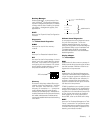
Glossary 13
SHULSKHUDOGHYLFH
An internal or external devicesuch as a
printer, a disk drive, or a keyboardcon-
nected to a computer.
3*$
Abbreviation for pin grid array, a type of
microprocessor socket that allows you to
remove the microprocessor chip.
SL[HO
Arranged in rows and columns, a pixel is
a single point on a video display. Video
resolution640 x 480, for exampleis
expressed as the number of pixels across
by the number of pixels up and down.
3267
Acronym for power-on self-test. Before
the operating system loads when you turn
on your computer, the POST tests various
system components such as RAM, the
disk drives, and the keyboard.
SSP
Abbreviation for pages per minute.
34)3
Abbreviation for plastic quad flat pack, a
type of microprocessor socket in which
the microprocessor chip is permanently
mounted.
351
A synonym for the MS-DOS device name
LPT1.
SURJUDPGLVNHWWHVHW
The set of diskettes from which you can
perform a complete installation of an ap-
plication program. When you reconfigure
a program, you often need its program dis-
kette set.
SURWHFWHGPRGH
An operating mode supported by 80286
or higher microprocessors, protected
mode allows operating systems to
implement:
A memory address space of 16 MB
(80286 microprocessor) to 4 GB
(Intel386 or higher microprocessor)
Multitasking
Virtual memory, a method for
increasing addressable memory by
using the hard-disk drive
The Windows NT 32-bit operating system
runs in protected mode. MS-DOS cannot
run in protected mode; however, some
programs that you can start from
MS-DOSsuch as Windowsare able to
put the computer into protected mode.
36
Abbreviation for Personal System/2.
363%
Abbreviation for power-supply paralleling
board.
39&
Abbreviation for polyvinyl chloride.
4,&
Abbreviation for quarter-inch cartridge.
5$,'
Acronym for redundant arrays of indepen-
dent disks. This phrase was introduced by
David Patterson, Garth Gibson, and Randy
Katz at the University of California at Ber-
keley in 1987. The goal of RAID is to use
multiple small, inexpensive disk drives to
provide high storage capacity and perfor-
mance while maintaining or improving the
reliability of the disk subsystem.
Patterson, Gibson, and Katz described
five different methods, which are known
as RAID levels 1 through 5. Each level
uses one or more extra drives to provide
a means of recovering data lost when a
disk fails, so that the effective failure rate
of the whole disk subsystem becomes
very low.
Recently, Katz has defined a sixth meth-
od, RAID 6, which improves reliability
even further, and a configuration that pro-
vides no data recovery has popularly
become known as RAID 0.
5$,'
RAID 0 is commonly called
striping
. This
was not originally defined as a RAID level
but has since come into popular use. In
this array configuration, data is written


















